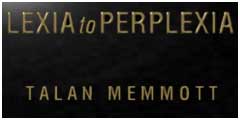I just saw a talk given by Katherine Hayles here at UT. Hayles is arguing that literary criticism is missing something when it ignores the material aspects of a text. She calls for a new form of literary criticism that she terms media-specific analysis. This form of criticism views the material aspects of a text as contributing as much to the meaning of a text as the text itself. She showed two examples of electronic texts that make visual arguments at the same time that they make textual arguments.

One was Lexia to Perplexia by Talan Memmott. This text takes control away from the reader by using text that disappears suddenly, text that becomes unreadable when you roll the mouse over it. Essentially, the movement of the mouse can unexpectedly change what is on the screen. The words and images are fused in this text. The create significance together because the words are part of the images.
The other text that Hayles showed during her talk was Nippon by Young-Hae Chang. Nippon uses moving text and music at the same time. Half the screen is red with white English words and half white with red Japanese characters. The words and characters move at a readable pace and then too fast to be read. It alternates between the two. The size of the letters also changes as well as the method by which they appear on the page. The text is also synchronized with the music. So this text has audio, visual, and textual characteristics which contribute to its meaning.
These two texts are examples of a fusion of visual and textual rhetoric. One is not subordinate to the other in the way that captions are to images, or images serve merely as examples of what is being discussed in a text.
Recent comments
2 years 29 weeks ago
2 years 44 weeks ago
2 years 44 weeks ago
2 years 50 weeks ago
3 years 4 weeks ago
3 years 4 weeks ago
3 years 4 weeks ago
3 years 6 weeks ago
3 years 6 weeks ago
3 years 6 weeks ago